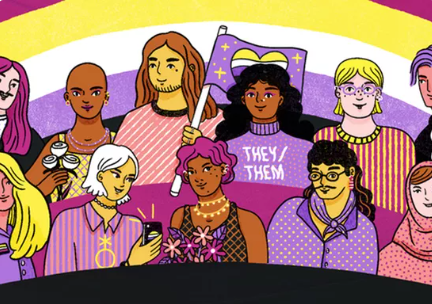
5 different nonbinary gender identities you may not be aware of
Shelby KretzShare
Expand your understanding of how nonbinary people experience gender in vastly unique ways
By Gabby Cushman
This month, our theme is the history of women’s and nonbinary people’s rights. A huge part of breaking down gender barriers in our society is understanding the nuances of nonbinary gender identities. Frequently, nonbinary is seen as a third and androgynous gender, but that’s not the case. In all actuality, nonbinary is an umbrella term that represents the many different gender identities outside the traditional gender binary of men and women. Here are five examples of specific nonbinary identities to help you better understand how gender can be experienced differently from person to person.
First, Some Things to Keep in Mind
- Not all nonbinary people use they/them pronouns- some use she/her and he/him, or a combination of the three, or even neopronouns, which are “new” pronouns created to express a person’s gender better than he/him, she/her, or they/them. Some examples of neopronouns include xe/xem and ze/hir.
- There’s a difference between someone’s gender identity and their gender expression. Someone’s gender identity, which includes the examples we’ll be looking at below, describes their personal experience with gender and how they see themselves. Gender expression is how someone outwardly presents their gender to the world, which can involve how a person dresses, styles their hair, pitches their voice, and more. A person’s gender identity and gender expression don’t need to parallel each other, as they’re distinct ways of defining someone’s unique experience with gender.
- Nonbinary identities can fall under the umbrella of trans identities as well. Some people on the nonbinary spectrum consider themselves “trans nonbinary,” while others do not. Not all trans people are nonbinary, and not all nonbinary people identify as trans. It’s up to the individual what feels most true to their personal gender experience.
- The traditional gender binary is a product of white supremacy. Many BIPOC communities had complex and inclusive ideas of gender before white values were pushed onto them. Think about how this intersectionality plays into our modern-day understanding of nonbinary identities.
#1- Agender
A person who is agender does not identify as any particular gender and often considers themselves to have no gender. An agender person may instead identify as gender neutral, which is another valid interpretation of this label. Although this term is relatively new, people who experience this genderless feeling have existed throughout history. Many religions even consider their “God” to be agender!
#2- Genderfluid
Someone who considers themselves genderfluid experiences a gender identity that is not fixed and varies over time. This change can happen daily, month to month, or multiple times throughout the day. Their gender identity can shift from masculinity to femininity, androgyny, genderlessness, or to a type of gender identity that is unique to them. Genderfluid individuals often adjust their gender expression to match the gender identity they are feeling at that given moment.
#3- Demiboy/Demigirl
A person who identifies as demiboy partially identifies with masculinity but does not wholly fit into the binary of boy/man. The same goes for a person who considers themselves to be demigirl, but does not fully fit in with the binary of girl/woman. Any person can identify as demiboy or demigirl regardless of the gender they are assigned at birth. For example, a person assigned female at birth may end up resonating with the identity of demiboy.
#4- Two-Spirit
Two-spirit is an umbrella term for the diversity of genders in many indigenous cultures. Indigenous people are the only ones to use this label due to its cultural significance. The idea of two-spirit individuals dates back centuries and was not only accepted but praised in most First Nation communities. The term “two-spirit” was created to bring indigenous understandings of gender into contemporary conversations about native lifestyles.
#5- Genderqueer
Genderqueer has a very similar meaning to nonbinary. A genderqueer person does not follow traditional gender distinctions but rather identifies with neither binary genders or a combination of the binary genders. To some, nonbinary and genderqueer can be used interchangeably, but others see the labels as having small but significant differences. Some people prefer to go by genderqueer because they see it as a defiance of the gender roles pushed onto them.
These five identities are just scratching the surface of the plethora of gender identities under the nonbinary umbrella. Take some time to research other gender identities with your little ones and challenge yourself to expand your understanding of gender. You may even start seeing nuances in how you feel and express your gender!
For more ways to bring social justice to the little ones in your life, sign up for the LJL newsletter here.
